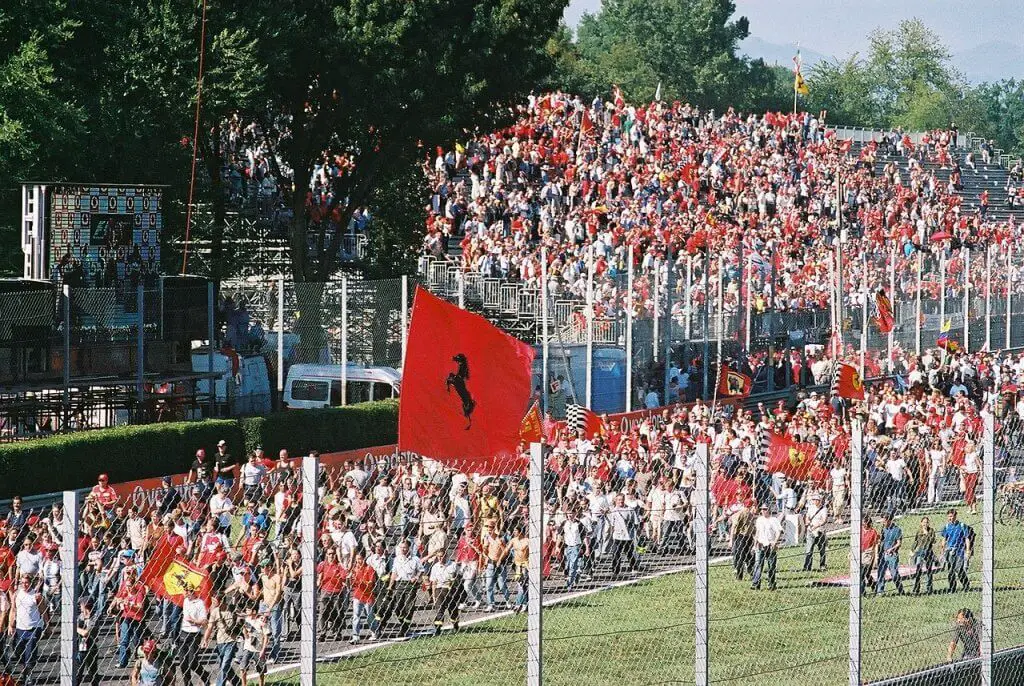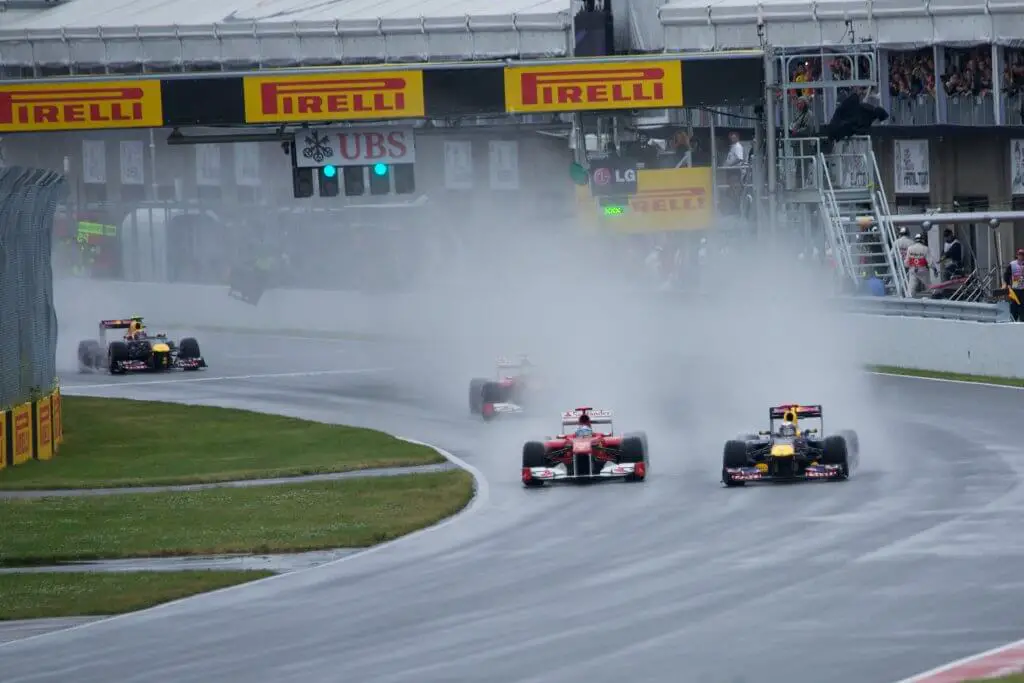Which Grands Prix were won over the furthest distance? Which races were won in the shortest time? We take a look at the longest F1 races and the shortest F1 races in history!
THE SHORTEST F1 RACES
THE SHORTEST F1 RACE
The 2021 Belgian Grand Prix broke a 30 year old record to become the shortest ever Formula 1 race. The race was held in treacherous conditions, with no racing actually taking place. A handful of laps were completed under Safety Car conditions – just enough to declare a result, with half points awarded.
Though three laps of the race were completed behind the Safety Car, F1’s rules mean that only one counted towards the official classification. Max Verstappen therefore won the race after one lap, completed in a time of three minutes and 27.071 seconds. With just 6.880km covered, the 2021 Belgian Grand Prix set a new record as the shortest race – in terms of both time to complete and distance raced.
OTHER RACES WHICH LASTED LESS THAN AN HOUR
There have been only four other Formula 1 races which were won in a time of less than an hour. The 1991 Australian Grand Prix previously held the record as the shortest F1 race. The final race of the 1991 season was held at the Adelaide Street Circuit in appalling conditions, with the Grand Prix lasting only 24 minutes.
The race began in heavy rain, with Ayrton Senna leading the field away from pole position. It was not long before drivers began to lose control of their cars – both Nicola Larini and Jean Alesi aquaplaned and crashed in the same section of the circuit, leaving debris strewn across the track. The race leaders narrowly avoiding the battered cars. Top tier drivers – including Nigel Mansell and Nelson Piquet – spun on the slippery surface, while leader Senna gestured for the race to be stopped. The Brazilian got his wish, with the race abandoned after only sixteen laps – or just under 53 kilometres. Senna’s win, albeit scoring only half points, confirmed McLaren’s status as 1991 Constructors’ Champions.
The other two races which were won in a time of less than an hour both took place in 1975. The 1975 Spanish Grand Prix was abandoned in tragic circumstances after 29 laps. On lap 26, Rolf Stommelen’s car left the circuit and fatally injured four onlookers. Stommelen survived the crash, suffering only broken bones. The race was cancelled soon after, having lasted only 43 minutes.
Four months later, the 1975 Austrian Grand Prix came to a premature end due to poor weather conditions. Vittorio Brambilla recorded his only Grand Prix win after 58 minutes of racing. The only other race less than an hour in length was the 2009 Malaysian Grand Prix, which was red-flagged after 55 minutes and not restarted, again due to heavy rain. Half points were awarded at all of these races.

THE SHORTEST F1 RACE TO REACH FULL DISTANCE
Michael Schumacher winning in a time of one hour and 14 minutes, the 2003 Italian Grand Prix is the shortest F1 race to reach full distance. Schumacher completed the race at an average speed of 247.586km/h – which remains the record for the fastest race in history.
The shortest F1 race which was not red-flagged is the 2023 Italian Grand Prix, which Max Verstappen won in a time that was 38.695 seconds faster than the time in which Schumacher won the 2003 Italian Grand Prix. However, the 2023 race was shortened by two laps and did not run to its full scheduled distance.
THE SHORTEST DISTANCE COVERED IN A FULL RACE
With the race distance of 241.38km, the 1983 Detroit Grand Prix is the race which was contested over the shortest distance – excluding races which did not run to their full scheduled distance. Despite its short distance, the race nearly reached the two-hour time limit, with Michele Alboreto winning in a time of one hour and 50 minutes.
THE SHORTEST F1 RACES
| Race | Circuit | Time Won In | |
|---|---|---|---|
| 1 | 2021 Belgian Grand Prix | Spa Francorchamps | 0:03:27.071 |
| 2 | 1991 Australian Grand Prix | Adelaide | 0:24:34.899 |
| 3 | 1975 Spanish Grand Prix | Montjuic | 0:42:53.700 |
| 4 | 2009 Malaysia Grand Prix | Sepang | 0:55:30.622 |
| 5 | 1975 Austrian Grand Prix | Österreichring | 0:57:56.690 |
| 6 | 1984 Monaco Grand Prix | Circuit de Monaco | 1:01:07.740 |
| 7 | 1978 Italian Grand Prix | Monza | 1:07:04.540 |
| 8 | 2001 Belgian Grand Prix | Spa Francorchamps | 1:08:05.002 |
| 9 | 2023 Italian Grand Prix | Monza | 1:13:41.143 |
| 10 | 2003 Italian Grand Prix | Monza | 1:14:19.838 |
| 11 | 2005 Italian Grand Prix | Monza | 1:14:28.659 |
| 12 | 2024 Italian Grand Prix | Monza | 1:14:40.727 |
| 13 | 1987 Italian Grand Prix | Monza | 1:14:47.707 |
| 14 | 2006 Italian Grand Prix | Monza | 1:14:51.975 |
| 15 | 2004 Italian Grand Prix | Monza | 1:15:18.448 |
| 16 | 2019 Italian Grand Prix | Monza | 1:15:26.665 |
| 17 | 2017 Italian Grand Prix | Monza | 1:15:32.312 |
| 18 | 2001 Italian Grand Prix | Monza | 1:15:58.493 |
| 19 | 2002 Italian Grand Prix | Monza | 1:16:19.982 |
| 20 | 2009 Italian Grand Prix | Monza | 1:16:21.706 |
THE LONGEST F1 RACES
THE LONGEST F1 RACE
The epic 2011 Canadian Grand Prix – which featured six Safety Car stints and a long red flag period – holds the record as F1’s longest ever race. Jenson Button won in a time of four hours and four minutes – seven minutes longer than the 1951 Indianapolis 500 took to complete. Because of the red flag period, Button completed the race at an average speed of 74.864km/h – the slowest average speed at which a Grand Prix has been won.
THE LONGEST F1 RACE DISTANCE
The 1951 French Grand Prix was run over a distance of 601.832km – the longest ever distance completed in a single race. This was the first of three races which was won by two drivers sharing a single car. Luigi Fagioli and Juan Manuel Fangio collectively raced 77 laps of the Reims-Gueux circuit to win for Alfa Romeo.
To put the length of the 1951 French Grand Prix in context, current F1 rules state that races should be close to 305km, with the race ending on the lap which will reach that distance. The race with the longest distance this millennium is the 2000 Japanese Grand Prix, which was contested over 310.596km.
THE LONGEST F1 RACE WITH NO RED FLAGS
The longest F1 race to feature no stoppages was the 1954 German Grand Prix, in which Juan Manuel Fangio completed 22 laps of the legendary Nurburgring layout in three hours and 45 minutes. The race distance had been increased by four laps since F1’s previous visit in 1953. This was the record for the longest non-Indianapolis 500 race until the 2011 Canadian Grand Prix.
The longest race to not feature a Red Flag so far this millennium is the 2017 Singapore Grand Prix. The race ran for 58 of its scheduled 61 laps before the two-hour time limit was reached, with Lewis Hamilton taking victory in two hours and three minutes.
THE LONGEST F1 RACES
| Race | Circuit | Time Won In | |
|---|---|---|---|
| 1 | 2011 Canadian Grand Prix | Circuit Gilles Villeneuve | 4:04:39.537 |
| 2 | 1951 Indianapolis 500 | Indianapolis Motor Speedway | 3:57:38.050 |
| 3 | 1955 Indianapolis 500 | Indianapolis Motor Speedway | 3:53:59.530 |
| 4 | 1956 Indianapolis 500 | Indianapolis Motor Speedway | 3:53:28.840 |
| 5 | 1953 Indianapolis 500 | Indianapolis Motor Speedway | 3:53:01.690 |
| 6 | 1952 Indianapolis 500 | Indianapolis Motor Speedway | 3:52:41.880 |
| 7 | 1954 Indianapolis 500 | Indianapolis Motor Speedway | 3:49:17.270 |
| 8 | 1954 German Grand Prix | Nurburgring | 3:45:45.800 |
| 9 | 1958 Indianapolis 500 | Indianapolis Motor Speedway | 3:44:13.800 |
| 10 | 1957 Indianapolis 500 | Indianapolis Motor Speedway | 3:41:14.250 |
| 11 | 1959 Indianapolis 500 | Indianapolis Motor Speedway | 3:40:49.200 |
| 12 | 1956 German Grand Prix | Nurburgring | 3:38:43.700 |
| 13 | 1960 Indianapolis 500 | Indianapolis Motor Speedway | 3:36:11.360 |
| 14 | 1957 German Grand Prix | Nurburgring | 3:30:38.300 |
| 15 | 1951 German Grand Prix | Nurburgring | 3:23:03.300 |
| 16 | 1951 French Grand Prix | Reims | 3:22:11.000 |
| 17 | 1954 Spanish Grand Prix | Pedralbes | 3:13:52.100 |
| 18 | 1950 Monaco Grand Prix | Circuit de Monaco | 3:13:18.700 |
| 19 | 1957 Monaco Grand Prix | Circuit de Monaco | 3:10:12.800 |
| 20 | 1952 German Grand Prix | Nurburgring | 3:08:13.300 |
Header Image: Mark McArdle, Flickr , CC BY-SA 2.0
This post was originally published in February 2021 and has since been updated.

